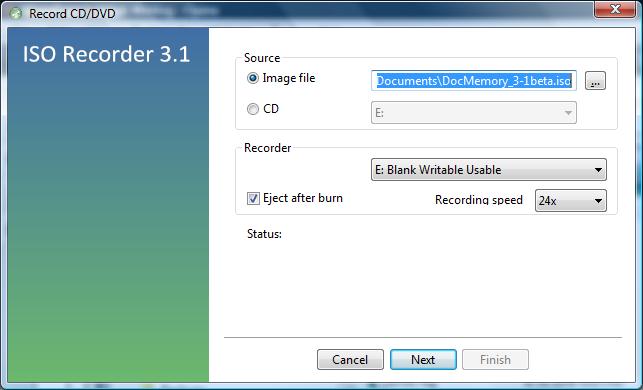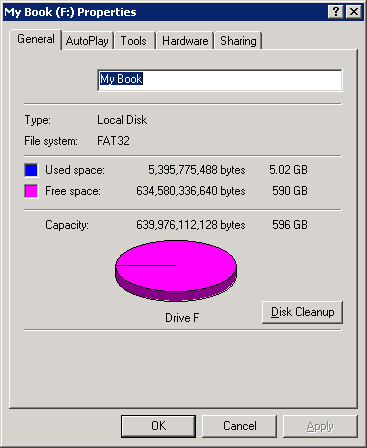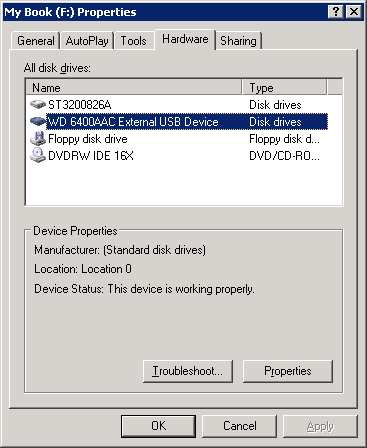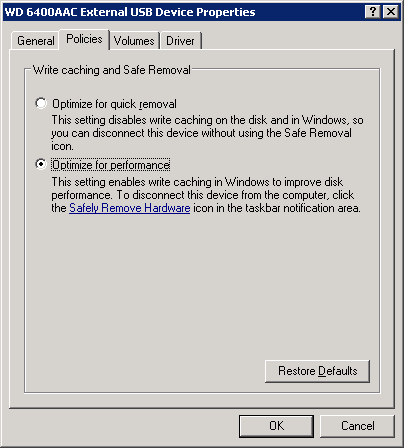Tue, Sep 29, 2009 3:23 pm
Joker Mail Forwarding
The domain registrar,
Joker.com allows you
to have email addressed to someone at a domain registered with them forwarded
to an email account at another domain. E.g., one could forward email
addressed to pamela@example.com to pamela@somewhereelse2.com. Joker.com
imposes the following limits for that service:
- 40 mail addresses per domain
- 10486kB as the maximum size of a single mail
- 200 mails per day per address
Joker.com provides the option of filtering spam. Hopefully, email rejected
as spam doesn't count towards the 200 email messages per day limit.
The service might not be suitable for someone who receives large attachments
to messages, because of the 10 MB limit on the size of a message.
[/network/email/joker]
permanent link
Sun, Sep 27, 2009 3:25 pm
Memory Errors Encountered During Testing on 2009-09-26
My wife's Windows XP Professional PC would boot into Windows, but whenever
she logged on and tried to do anything, the system would reboot. I
ran memory tests on the system with five free programs and one commercial
program.
More Info
[/os/windows/utilities/diagnostic/memory]
permanent link
Sat, Sep 26, 2009 5:51 pm
HR Tag Within Pre Tag
When I checked a webpage for HTML errors using the
W3Creg; Markup Validation
Service, I saw errors such as the following reported:
 Line 165, Column 4:
document type does not allow element "HR" here; missing one of
"MAP", "IFRAME", "BUTTON" start-tag
Line 165, Column 4:
document type does not allow element "HR" here; missing one of
"MAP", "IFRAME", "BUTTON" start-tag
<hr>
The mentioned element is not allowed to appear in the context in which
you've placed it; the other mentioned elements are the only ones that
are both allowed there and can contain the element mentioned.
This might mean that you need a containing element, or possibly that
you've forgotten to close a previous element.
One possible cause for this message is that you have attempted to put a
block-level element (such as "<p>" or "<table>") inside an
inline element (such as "<a>", "<span>", or "<font>").
The problem occurred because I had placed <hr> between
<pre> and </pre> tags.
I had something like the following:
<pre>
This is some text
<hr>
This is some more text
</pre>
I eliminated the error by placing a end pre tag after the
first block of text and a begin pre tag before the second
block of text.
<pre>
This is some text
</pre>
<hr>
<pre>
This is some more text
</pre>
References:
-
CSS - html/css validation error
Date: 2008-02-25
Ultrashock Forums
[/network/web/html]
permanent link
Fri, Sep 25, 2009 7:09 pm
Windows XP System Not Using Primary DNS
After a user rebooted her system, email she sent to an internal POP3 email
server was being rejected. When I checked the email server's log file, I found
that it was rejecting the email because it saw the email coming from the outside
address of the firewall. It saw the "to" address of the email message she was
trying to send as one that was not destined for an account on the email server
and rejected it with a "relaying denied" message. The email server was
configured to allow relaying from the IP address of her PC, but since it
saw the email coming through the external firewall, it rejected it.
When I tried pinging the internal email server, mail.example.com, from
her system, instead of its internal address, 192.168.0.25, being used, I saw
the external address for the firewall was being used. I checked her
/windows/system32/drivers/etc/hosts file first. I didn't see
any entry for mail.example.com there. Nor did I see the address cached
on her system when I entered the command ipconfig /displaydns |
find /i "mail.example.com" at a command prompt. So I used a
sniffer to observe
the network traffic from/to her system. I saw that her system was
querying the DNS server configured as the secondary name server for her
system, which was an external DNS server provided by her Internet Service
Provider (ISP) rather than the internal name server on her
LAN.
I tried ipconfig /flushdns, but that made no difference.
Her system continued to query the secondary name server and didn't seem
to ever cache the address for mail.example.com. When I tried
ipconfig /registerdns, the system then queried the primary
DNS server again.
The /registerdns argument to the ipconfig command
"refreshes all DHCP leases and re-registers DNS names." The system had
a static IP address, so the "re-registers DNS names" function of the
command must have fixed the problem.
When she tried sending her email message again, though,
it was rejected by the internal mail server. I had her restart her email
client, Microsoft Outlook, and that resolved the problem. Apparently, Outlook
also maintains its own cached information for the mail server it uses. I
still didn't see the internal mail server's address cached when I issued
an ipconfig /displaydns command, though.
The long term solution, though, to prevent the problem recurring would
be to set up another internal DNS server to use as the secondary DNS
server.
References:
-
XP not using Primary DNS
Date: March 20, 2009
TechTalkz.com Technology @ your
fingertips
-
Configuring IP Addressing and Name Resolution
Microsoft TechNet: Resources for
IP Professionals
-
When does a Windows client stop using a secondary DNS server and revert back
to primary
Date: August 11, 2009
Server Fault
-
Renew DNS client registration using the ipconfig command
Updated: January 21, 2005
Microsoft TechNet: Resources for
IP Professionals
[/network/dns/windows]
permanent link
Tue, Sep 22, 2009 7:17 pm
Creating a CD Image with ISO Recorder
I needed the capability to create an
ISO file from a CD on
a Windows Vista system. I installed the 64-bit version of
ISO Recorder
for Vista. Once I had it installed, I was able to create the file I needed
by the following steps:
- Click on the Start button.
- Select Computer.
- Right-click on the CD/DVD drive and select "Create image from CD/DVD".
- Select the location and file name for the ISO file you wish to
create.
- Click on the Next button.
- Click on the Finish button to exit ISO Recorder.
ISO Recorder also then allowed me to right-click on the ISO file and choose
"Copy image to CD/DVD" to create another copy of the CD.

[/os/windows/software/utilities/cd-dvd/ISO_Recorder]
permanent link
Tue, Sep 15, 2009 12:31 pm
Calculating the Number of Days Between Two Dates in Excel
The
datedif
function can be used in Microsoft Excel to calculate the number of days between
2 different dates.
The syntax for the DATEDIF function is as follows:
=DATEDIF(Date1, Date2, Interval)
Where:
Date1 is the first date,
Date2 is the second date,
Interval is the interval type to return.
If Date1 is later than
Date2, DATEDIF
will return a #NUM! error. If either
Date1 or Date2
is not a valid date, DATEDIF will return a
#VALUE error.
The Interval value should be one of
the following:
|
Interval
|
Meaning
|
Description
|
m |
Months |
Complete calendar months between the dates. |
d |
Days |
Number of days between the dates. |
y |
Years |
Complete calendar years between the dates. |
| ym |
Months Excluding Years |
Complete calendar months between the dates as if they were of the same year.
|
yd |
Days Excluding Years |
Complete calendar days between the dates as if they were of the same year.
|
md |
Days Excluding Years And Months |
Complete calendar days between the dates as if
they were of the same month and same year. |
If Interval is not one of the items listed in
above, DATEDIF will return a
#NUM error.
Examples of datedif
usage
[/os/windows/office/excel]
permanent link
Sun, Sep 13, 2009 5:04 pm
File System not Supported on This Device Optimized for Removal
I was unable to backup a disk drive to an external drive attached
to a system via a USB
connection using the NTBackup program. The backup failed once the
backup file reached 4 GB in size, which is the maximum size for the
FAT32 file system,
which was the file system on the Western Digital My Book USB external
drive when I purchased it. So I decided to change the file system to
NTFS by reformatting
the drive. But I received an error message when I tried to convert the file
system.
C:\>format f: /fs:ntfs
NTFS file system is not supported on this device optimized for removal.
To change the way this device is optimized, select the Policies tab in
the device's property sheet.
To change the file system, I right-clicked on the drive under
My Computer, then chose Properties.

I then clicked on the Hardware tab and selected the drive.

I then clicked on the Properties button and then the
Policies tab. I changed the setting from "Optimize for quick
removal" to "Optimize for performance". The "optimize for quick removal"
setting disables write caching on the disk and in Windows, so you
can disconnect the device without using the Safe Removal icon. The
"optimize for performance" setting enables write caching in Windows to
improve disk performance. When you choose this option, to disconnect
the device from the computer, you should click the "Safely Remove Hardware"
icon in the taskbar notification area."

I then clicked on the OK button. I clicked on a
second OK button to close the window.
I was then able to reformat the drive from the FAT32 file system to the
NTFS file system.
C:\>format f: /fs:ntfs
The type of the file system is FAT32.
The new file system is NTFS.
Enter current volume label for drive F: My Book
WARNING, ALL DATA ON NON-REMOVABLE DISK
DRIVE F: WILL BE LOST!
Proceed with Format (Y/N)? y
Verifying 610477M
Volume label (32 characters, ENTER for none)? ACI-3
Creating file system structures.
Format complete.
625129280 KB total disk space.
625044456 KB are available.
[/os/windows/filesystem]
permanent link
Sat, Sep 12, 2009 4:06 pm
CT6472Z40B Memory Module
Specifications for a 512 MB
184-pin DIMM DDR PC3200 memory module with part number CT6472Z40B from
Crucial Technology.
[/hardware/pc/memory]
permanent link
Tue, Sep 08, 2009 9:53 pm
Hello Kitty Online - Trojan.Win32.Generic!BT
A family member got an offer to become a beta tester for
Hello Kitty Online
today. The email message she received provided a link to download
a setup program
HKO_Downloader.exe. After she downloaded
the file, I had her submit it to
Virustotal
, a site that checks files for malware with multiple antivirus programs.
The
Virustotal analysis of the file showed 2 of the 41 programs it used
to check the file reporting a potential issue with the file. Note: someone
else had uploaded a file named
HKO_Island_of_Fun.exe on
September 3, 2009 that Virustotal identified as being an identical file
because that file had an identical
hash
value.
File HKO_Island_of_Fun.exe received on
2009.09.03 20:55:55 (UTC)
Current status: finished
Result: 2/41 (4.88%)
The two that identified the file as potentially being malware were as
follows:
| Antivirus | Version | Last Update | Result |
|---|
| McAfee+Artemis | 5730 | 2009.09.03 |
Suspect-29!4A5CA8AF0ECD |
| Sunbelt | 3.2.1858.2 | 2009.09.03 |
Trojan.Win32.Generic!BT |
Information on Mcafee+Artemis is available at
McAfee Artemis Technology. An evaluation of McAfee+Artemis is available
at
Anti-Virus Comparative Technology Preview Report McAfee Artemis.
Sunbelt's
Trojan.Win32.Generic!BT Information and Removal webpage shows the following:
| Threat Name | Trojan.Win32.Generic!BT |
| Summary |
Trojan.Win32.Generic!BT is a downloader associated with rogue security
programs (also called “scareware.”) Once downloaded, the rogues
pretend to scan a victim.s computer for malware then display false warnings
that the machine is infected. It tries to convince victims to purchase useless
security software. |
| Category |
Trojan
|
| Level |
High
|
| Advice | Remove |
| Description |
Other names: F-Secure: Trojan-Downloader.Win32.FraudLoad.ffz
Kaspersky: Trojan-Downloader.Win32.FraudLoad.ffz
Microsoft: TrojanDownloader:Win32/FakeVimes |
| Release Date | Apr 7 2009 |
| Last Updated | Aug 7 2009 |
| File Traces | - No traces available. |
The HKO_Downloader.exe file downloads the actual software needed to participate
in Hello Kitty Online, which is
a site run by Aeria Games. I
concluded that they may have licensed a downloading program that some others
may use for nefarious purposes, but I didn't see sufficient reason to be
concerned in this case and told her she could download the software and
participate in the beta testing.
[/security/malware]
permanent link
Mon, Sep 07, 2009 6:58 pm
HP Printer Processes
While checking a "Virtual Memory Minimum Too Low" warning message on a Windows
XP system, I found the following HP processes running:
According to the
Uniblue Process Library:
hpqste08.exe is a process installed alongside HP Imaging devices
and provides additional configuration options for these devices. This
program is a non-essential process, but should not be terminated unless
suspected to be causing problems.
hpqste08.exe is a process installed alongside HP Imaging devices and
provides additional configuration options for these devices. This program
is a non-essential process, but should not be terminated unless suspected
to be causing problems.
hpqnrs08.exe hpqnrs08.exe is a
Network Monitor from Hewlett-Packard Development Company, L.P. belonging
to HP Digital Imaging. This is a network device rediscovery service.
[/os/windows/printers]
permanent link

Privacy Policy
Contact


 Line 165, Column 4:
document type does not allow element "HR" here; missing one of
"MAP", "IFRAME", "BUTTON" start-tag
Line 165, Column 4:
document type does not allow element "HR" here; missing one of
"MAP", "IFRAME", "BUTTON" start-tag




